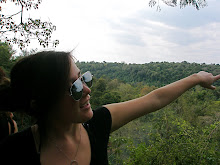
After my stay in Sucre I took a 3 hour bus to Potosi, what used to be one of the wealthiest mining towns in the continent. Unfortunately I decided to go out the night before . . . waking up hungover at six in the morning and then going to a city at about 4500 meters above sea level isn´t the best idea I´ve ever had. But I toughed it out because I really wanted to see the mines. The story of Potosi is that huge amounts of silver were discovered in the mountains there, thus it became a huge and very prosperous mining town. Since then the deposits have been depleted and only about 10% of what they take from the mine is useful materials (the rest they call waste). The main industry of the town is still the mine, thus it has become more and more impoverished.
I arrived in Potosi around 10am and went to a hostel to sleep some. Then around one I had the mine tour. We were 5 tourists and 2 guides. First we went to a facility to change into rubber boots, helmets and jackets. On the wall was spray painted ¨Argentina: 0 Bolivia: 6 A day to never forget¨(but in Spanish). I thought that was pretty funny (the story behind this is that a few months ago the crappy Bolivian soccer team beat the really good Argentina team because the match was in Bolivia at a really high altitude thus making it extremely difficult for the team not accustomed to the extreme altitude). From there we went to a miners market which was basically just a store where you could by mining tools, explosives, soda, water and coca leaves (used for altitude sickness and as a part of Bolivian culture). Then we headed to a plant where we saw how they process what is taken from the mines, separating usable materials from the waste. It was so strange driving further and further up towards the mine because I could feel the pressure from climbing in altitude.
Once we got to the mine there was a collection of little shacks that the miners use to change clothes and leave their tools in. All around the doors and the entrance to the mine was this red paint looking stuff splattered on the wall. Our guide explained to us that it was llama blood - like a sacrifice . . . Walking though the first level of the mine was interesting. Some parts were really high and I could walk upright comfortably but other parts I had to slouch down almost to my knees. We then got to a little room called the mine museum. It was a collection of statues of different types of men that had been involved in the mine. One was the devil of the mine which had all kinds of ribbons and coca leaves around it. Our guide explained that these were offerings to the god of the mine in hopes that he will keep the miners safe and keep the mine going. In the little room we sat down with the guide and had a really interesting talk about the life of miners and about coca.
He explained that mining is a family tradition and that he himself is a miner when there isn´t much tourism. We also learned that the people generally live for about 15 years after they start in the mine because of physical injuries, accidents and horrible air quality (basically breathing the air in the mine so much is poisonous). This was really sad, especially considering that there are young kids who work in the mine . . . We also talked about the production of the coca plant in Bolivia. There is a huge portion of the Bolivian population who cultivate this plant and deepened on it as a living. Basically the coca plant serves two purposes or two markets. One is as coca leaves which visitors use to combat altitude sickness or by Bolivians who eat them as a part of culture or tradition (they way Argentines drink mate). The other market of course is the production of cocaine which is huge in Bolivia. During the Bush administration he attempted to come into Bolivia and eradicate these coca crops which was devastating for the farmers who's livelyhoods depended on it. It turned quite violent for a while and there were hundreds of Bolivians who lost their lives. Even though I´ve learned about this before, it was so different hearing it from someone who had lived through the experience. And it makes me so frustrated with my government and its tendencies to act without consideration of the effects on others. Or without logic . . . . production can´t truly be ended until there is no demand . . . ahh I don´t want to get started on this. Back to the mine .. .
After the museum we continued on to the second level of the mine. We walked through a small arch and I could feel the temperature drop, the air thin and the dust increase a lot. At this point I knew I wouldn´t be able to go further (between the hangover, altitude and poor air quality). So I went back and waited outside the mine with another couple from the States who opted not to go inside. After the rest came back we detonated some dynamite which was pretty impressive. All in all it was a really informative and impressing experience which I highly recommend. Later that night I hoped on a bus and headed to La Paz, the effective capital of Bolivia.

No comments:
Post a Comment